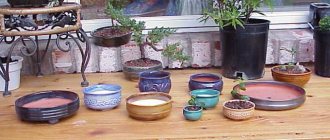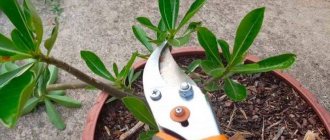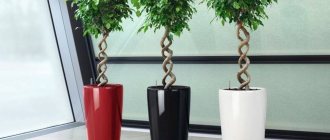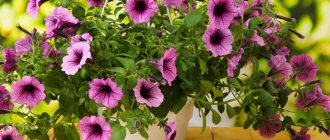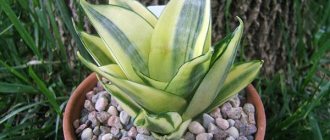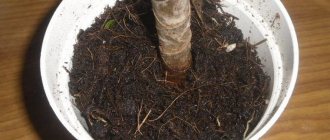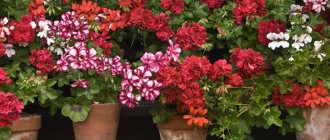Curved dwarf trees formed using the bonsai technique have recently become increasingly popular. They are often used as unusual green decoration for a home, balcony or yard, and for many gardeners, growing such miniatures becomes an exciting hobby. And although an adult plant can always be bought at a specialty store, it is not nearly as interesting as planting the seeds of a bonsai tree yourself and watching its development day after day.
Popular types of trees to grow
Literally translated, the art of bonsai means “growing in a tray.” It allows you to get smaller copies of ordinary trees, coniferous and deciduous, by cutting roots, pruning shoots, and using a substrate poor in minerals. To create a unique garden of dwarf crops with a height of 2 to 110 cm, trees with long growth are used.
A bonsai tree will be a unique decoration for any room.
There are several groups of plants that can be grown in miniature:
- The lowest plants are from 9 to 20 cm tall. These are juniper, spruce, serviceberry.
- 20-30 cm high. Barberry, pine, maple are suitable.
- Reaching 30-70 cm. These are Scots pine, birch, hazel.
- Trees up to 60-100 cm. Choose oak, larch, black pine.
- The tallest representatives are more than 100 cm. Acacias, chestnuts, and plane trees are grown in this way.
Note! You can create original green corners at home, where bonsai trees will harmoniously combine with lushly blooming roses or violets.
Some of the best plants for bonsai from seeds include the pepper tree or zanthoxylum, an unpretentious evergreen with dark bark and large, feathery leaves that emit a pleasant aroma. Well suited for creating living works of art.
A tiny variation of the olive tree also looks original; it is recommended that beginners start working with it. The tree has an unusual gray bark, the flowering period occurs in late summer - early autumn.
You can grow bonsai from almost any tree
Is it possible to grow bonsai from seeds at home?
Bonsai can be obtained in several ways. The easiest way is to take a tree from nature. Thus, high in the mountains, where the forest ends, there are old trees whose height is no more than 50 cm. Since their growing season is short, they grow only a few centimeters per year. Due to unfavorable natural conditions, they are severely curved. However, digging up such a plant is not easy. Since the root can reach 80 cm. In addition, permission from the owner of the site will be required.
They often resort to cuttings. However, not all plants take root well. Then an easier way to get a bonsai is to grow it from seeds.
However, it has a number of disadvantages:
- there is no guarantee that the seeds will germinate;
- the growing process takes a long time;
- not all seedlings survive.
Rules for processing and germination
Bonsai seeds can be processed for subsequent germination in several ways. Preparing seeds for germination is called stratification.
Cold way
Bonsai tree - types, cultivation and care at home
The method is chosen when bonsai seeds need to ripen. Relevant for thuja, pine, blue spruce. The step-by-step sequence of actions is as follows:
- Soak the seeds in warm water for 24 hours.
- Transferring the seed to the refrigerator. The time of exposure to cold depends on the variety. For southern tree species it lasts about 60 days, for northern ones – up to six months.
In this way, it is possible to create a temperature difference similar to what occurs in the natural environment.
Instead of refrigeration, it is permissible to place bonsai seed in cold soil, such as perlite or damp sand. After this, the containers are transferred to a cool but well-ventilated room, for example, a balcony.
Note! The use of organic soils can cause contamination of seeds with bacteria and mold, so it is better to avoid them.
Seeds are checked twice a month; rotten and spoiled ones are thrown away; those that hatch should be planted immediately.
Correct stratification is the key to growing a beautiful miniature tree
Warm stratification
The main purpose of the procedure is to awaken the seeds for bonsai. The required mode is humidity 70%, temperature – +20 ℃. This is done in several ways:
- The seeds are placed between layers of damp cloth and placed in a bright place where the sprouts will appear.
- Instead of napkins, it is permissible to use a wet sponge or coconut substrate.
To create a greenhouse effect, the structure is covered with film.
Combined processing method
In this way, pre-planting seeds of cedar and maple, sakura and other crops with a long growth cycle are carried out. This stratification involves alternating exposure to cold and heat. At the first stage, bonsai seeds are placed in cold water or taken to a cool room. And immediately before planting - in warm liquid. This allows the seeds to germinate quickly.
Growing bonsai from seeds is an art, but anyone can master it if they want.
Formation of bonsai from Japanese cedar:
Cedars can be shaped into almost any bonsai shape.
Looks best:
- unofficial;
- half-fairy tales;
- cascading styles.
The exception is Lebanese cedar, which is best suited to a formal, vertical style. Cedar bonsai respond well to shaping with wire to thicken the tree trunk, but it is advisable to do this no earlier than two years after the seed germinates and the tree grows.
Some varieties, such as Blue Atlas Cedar (Cedrus Atlantica Glauca), can be very slow growing, especially in a pot.
Himalayan bonsai are best pruned. Their wood is very elastic and if wire is used, the cedar bark is cut so deeply that it leaves scars on the tree.
Soil and container for growing bonsai
When considering how to grow bonsai from seeds at home, it is impossible to ignore the rules for choosing soil. The most preferred option is coarse sand, pre-calcined in the oven. They do it like this:
- The sand is washed in several waters.
- Pour into a thin layer onto a baking sheet.
- Place in the oven for 30 minutes at 180 ℃.
DIY bonsai - growing plants at home
To plant bonsai plants, clay granules that retain moisture well are suitable. Humus is also used for planting; heather soil with high acidity is especially good.
For coniferous species, add a little crushed needles of the selected plant to the soil. The substrate itself is a mixture of equal quantities of leaf soil, sand and humus. Deciduous trees grow best on baked clay mixed with lava and pumice. Fruit crops feel comfortable in a composition of leaf soil and compost, taken in a 1:1 ratio.
Note! To reduce humidity and prevent waterlogging, a drainage layer must be made.
Before planting bonsai seeds, you need to choose a pot. Flat, wide models are suitable for coniferous trees, and oval or round ones are suitable for trees with a curved crown. If the plant has a wide, powerful trunk, then a deep rectangular container is purchased for it. For representatives of flora with an open root system, narrow but deep containers are suitable.
The material for the pot can be anything: ceramics, clay, glass, even wood. But it is better to refuse cheap plastic - it does not have a long lifespan, and bonsai trees react negatively to replanting.
Color and decoration depend on the will of the owner, but you should not purchase a richly decorated vessel - it will distract attention from the living composition. The right choice for bonsai is a light container. Crops are also planted in dark brown, black, even pink pots.
Bonsai tree pot may have an unusual shape
What has grown? Reviews of bonsai seeds from Aliexpress
Bonsai seeds from Aliexpress are in great consumer demand due to the low price and exotic nature of the mini-format perennial plants themselves. With all this, you can find a lot of negative reviews about them on the Internet.
Manu, July 28, 2015 (link)
...customers say that the seeds dissolved after soaking, that clover grew, and the like. Alas, sellers often deceive by sending a fake or a fake. We have not yet been able to find a 100% honest seller without negative reviews...
...Indignantly I wrote to the seller that Celosia comb (comb) had grown, hoping for an apology and prompt dispatch by the fastest mail of the best seeds, and maybe even ready-made trees.
...The seeds were well packed. I unpacked it, put it in a gauze with water, two weeks passed, but nothing happened. I tried just putting it in the ground and watering it, but not a single seed sprouted either. In general, no matter how I tried, not only did my bonsai pine tree not grow, but not even a single seed sprouted...
Features of sowing seeds and plant care
Planting is carried out in spring or summer, and is also allowed in the first autumn month. The substrate is poured into the selected container so that approximately 2.5 cm remains to the edge. Then the germinated seeds are split into a row onto the prepared soil. They are sprinkled with a thin layer of sand, then pressed down with a wooden circle and carefully irrigated.
Bonsai oak - independent cultivation and care
Next, the container is covered with film or a bag and transferred to a dark place (the temperature should not be higher than +14 ℃).
Note! Every day the film needs to be removed for a few minutes for ventilation. The soil should always be moist, but not swampy.
After the sprouts appear, the film is removed and the pots are moved to a lighted place, under a lamp or on a windowsill. The formation of seedlings - removal of 2/3 of the main root - is carried out in 2-3 months. When the height of the bonsai trunk has reached 10 cm, the trees are planted in separate containers and begin to form a crown.
Proper planting is a guarantee that the tree will grow strong, but tiny
Features of agricultural technology of Japanese and red maple
The collection of bonsai seeds begins in the fall, the duration of stratification is 120 days. Seeds should be planted in April or early May.
Note! To speed up the germination of seeds, they are soaked in hydrogen peroxide for 48 hours. This will protect them from mold and disease.
Maple is good because it can have leaves of different colors, not only the usual green, red or yellow, but also non-standard blue, cyan, and purple tones.
Basic rules for growing maple bonsai:
- Choose a place that is bright, but protected from direct sunlight.
- The plant may die if the thermometer drops below - +5 ℃.
- Watering should be moderate but regular; the soil should not be allowed to dry out. In the summer heat, it is better to irrigate the soil twice a day - in the morning and in the evening.
- New branches are pruned throughout the year, but old shoots can only be formed in autumn or spring.
Note! You cannot feed maple trees in winter.
Features of lemon bonsai agricultural technology
The seeds do not need to be stratified, but must be taken from ripe citrus. To increase the chances of germination, several seeds are planted at the same time. Lemon requires a drainage layer of at least 1.5-2 cm. Seeds are planted to a depth of 1.5 cm. After sowing, the pot is covered with a plastic bag and placed in a room with a temperature of +18 ℃.
After germination, the film is removed and the plant is placed in a bright place. Subsequent care includes watering and fertilizing. Use complexes for indoor plants in half the dosage.
Lemon bonsai is an amazing plant, a real home decoration
Features of cedar agricultural technology
Japanese cedar is an evergreen classic of oriental art. The tiny tree looks very interesting and will be a worthy decoration for a home garden decorated in Chinese style.
Cedar seeds germinate without problems, but react very negatively to excessive amounts of water. To grow cedar, you should follow these steps:
- Soak the seeds in warm water for a day.
- Dry the seeds completely.
- Place them in the sun for 15 minutes.
- Place in a plastic zip bag, seal tightly and refrigerate for a month.
- After the sprouts appear, plant them in the ground.
- Water carefully.
- You should not cover it with film, but it is important to maintain constant humidity of the substrate.
Many people are interested in how long bonsai grows. It all depends on the species and type of wood. For example, a Lebanese cedar will grow only 10 cm in 10 years.
Bonsai cedar looks very elegant and unusual
Features of Japanese pine agricultural technology
Japanese white pine grown using bonsai technology looks very good. Seeds begin to germinate in early spring; if they are fresh, sprouts will appear very quickly. The cold stratification method is used. Pine trees need a bright place, otherwise the needles will be dull and weak.
Note! Excessive soil moisture is the cause of root rot. Watering should be careful.
Botanical description of the tree
Quite often, decorative coniferous trees, namely Japanese pine, are planted as bonsai at home. There are 4 main varieties that are used in this art: black, mountain, ordinary and white. The height of an adult tree can vary from 5 to 100 cm. Growing tiny specimens up to 10 cm in height is considered the highest degree of mastery of the art of bonsai, since such plants have rather fragile branches and crown.
Japanese pine (Pinus thunbergii) is distinguished by its cone-shaped shape and tall trunk with smooth red-brown bark. The needles of the plant are dark, with a silvery tint, and have the shape of an arc. The needles themselves are located on the branch in pairs.
In the wild, the tree is found mainly in Japan, less often in other Asian countries. But as a bonsai, this type of pine has spread throughout the world because it tolerates unfavorable conditions and minimal care.
Important! If wire is used to shape the bonsai, it must be removed every year, otherwise it will grow to the bark and injure the plant.
The crown of the tree is quite spreading and lends itself well to curly pruning. Japanese pine also has a strong trunk and a massive lower part, which allows the plant to gain a good foothold in the soil.
Gardeners prefer to grow this tree as a bonsai because the branches fit perfectly into the overall composition, visible among the dense needles.
Due to the fact that Japanese pine is considered an unpretentious evergreen plant, it can be planted with equal success both in well-lit areas and in the shade. This plant is especially often used in landscape design as a decoration for stone gardens, which are very popular in Japanese culture.
Read more about the use of pine trees in landscape design of the site.
Watering, fertilizing, wintering
The tiny trees are grown in small pots, so watering must be done very carefully. Two methods are used:
- Irrigation. Moistening the soil using a small watering can with a thin spout.
- Immersion. It is important that there are drainage holes in the bottom of the pot. The container with the plant is immersed in a basin filled with water for 5-10 minutes.
Note! Rainwater or tap water that has stood for at least 48 hours is suitable for irrigation.
For feeding, mineral complexes enriched with nitrogen, potassium, and phosphorus are used. You can also take fertilizers for indoor plants, but at a concentration of 50%, this will prevent excessive growth of shoots and foliage. Feeding rules:
- For the summer period, the potassium content is reduced.
- In spring and autumn, compositions rich in nitrogen and phosphorus are chosen.
Preparation for winter involves cleansing the plant of damaged and dried shoots and destroying pests. The pots are moved to a bright place, protected from drafts and blowing.
A bonsai garden is a dream that can come true. A variety of coniferous, deciduous and even fruit trees in miniature can be grown from seeds, the main thing is to follow the recommendations.
Departure point: cherry pit
The luxurious overseas guest is capricious and whimsical to grow, but, nevertheless, it is increasingly found in our gardens, parks, and city squares.
As befits a cherry, a Japanese beauty grows from the seed of a cherry fruit. The long journey of turning a small cherry pit into a mature tree is not the easiest, but the end result is worth the effort and time spent. It starts, of course, with the acquisition of planting material.
If you have an adult fruiting Japanese cherry tree in sight (from friends or on your own farm), you can stock up on seeds from it by collecting ripe fruits and freeing the seeds from the shell. Another option is to purchase ready-made seeds from an online store.
Picking
Plant picking is extremely important for the development of a tree. The first picking should be carried out immediately after germination. Small seedlings are planted in 100 ml cups. The substrate is made up of 7 parts turf soil, 3 parts sand (disinfection and roasting in the oven are mandatory) and 1 part humus. During the first pick, the root is shortened by 1/3.
The second picking of plants is carried out after 2 months. During the period of work, the root is pinched by 2/3 and the plant is slightly buried. The soil used is of the same composition.
The third pick is carried out after the sakura grows. But not more often than 2 months after the second procedure. It is recommended to repot the plant when the plant to pot height ratio is 2:1.
Preparing a place for planting seedlings
Special soil is used for bonsai. The heavy, moisture-intensive substrate consists of fractions of 3–5 mm. It has essential nutrients and is breathable. Pure akadama (ready-made soil for bonsai) is rarely used. Prepare a mixture with clay, humus, sand.
Small, wide-diameter ceramic containers are ideal for dwarfs. Their roots are covered, feel free, and are easily saturated with minerals from the air.
Breeding Tips
Bonsai are living decorations. In addition to the original design, they add freshness to the room, saturating and purifying it with air. Growing a tree is a creative, exciting process. Giving freedom of imagination, fills with pride for an extraordinary, one and only, specimen.
It takes many years of painstaking work to obtain a beautiful dwarf plant. Grown from a seed, it becomes entirely your creation. Watching germination and further growth is a pleasant, calming, and joy-giving experience.
Stages of planting seeds include:
- seed selection
- soil preparation
- disembarkation
When the decision to plant a bonsai has become a firm intention, it is necessary to decide on the species of the future tree. It is better and more correct to choose species that feel good in a given climatic region. Exotic species of the tropics are suitable for interior decoration.
Ficus, coffee tree, and schefflera trees are unpretentious when propagated. Citrus and coniferous varieties are popular. Myrtle and pine produce unusually beautiful, fragrant specimens. The breed must necessarily “lie on the heart”, because Getting a beautiful bonsai is not a matter of just one decade. It should not irritate either by sight or smell for many years.

